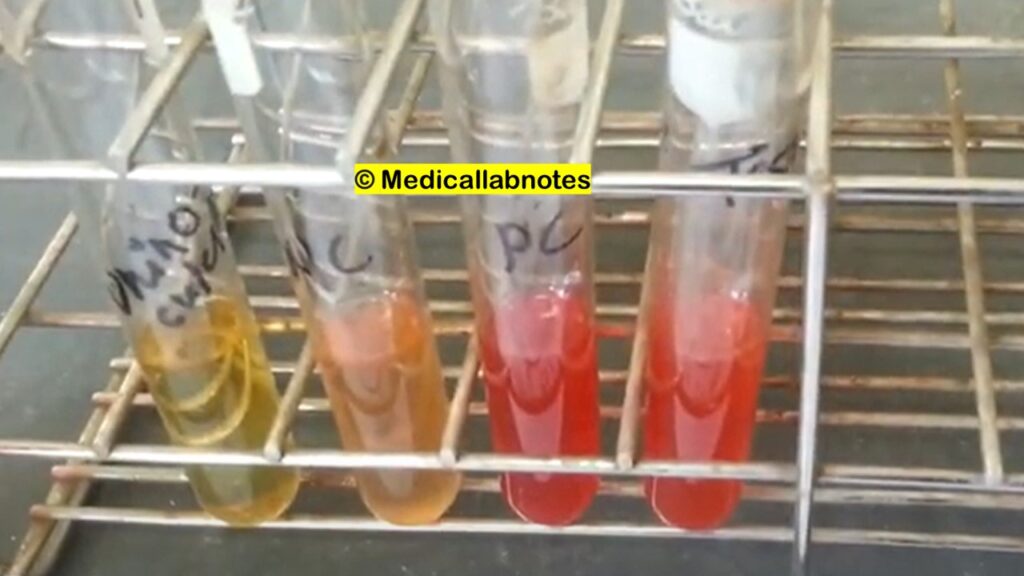Introduction of Methyl Red Test
Table of Contents
The Methyl Red test is for enteric gram-negative rods, as part of identification to species level. Its short name is MR test.
Principle of Methyl Red Test
The methyl red (MR) test uses to determine if an organism is able to produce stable acid end products from glucose fermentation Methyl red indicator (red color below pH 4.4; yellow color at pH 5.8) uses to determine the pH after an enteric gram-negative rod has fermented glucose to completion. All members of the Enterobacteriaceae give a positive methyl red reaction when tested for up to 24 hours due to the conversion of glucose to pyruvic acid by the Embden-Meyerhof pathway. After further incubation (2 to 5 days) those organisms that are MR positive continue to metabolize pyruvic acid to lactic, acetic, and formic acids by the mixed acid pathway and are able to maintain the acid pH (4.4).

Composition of MR-VP Broth
- Buffered peptone:7.0 g
- Glucose:5.0 g
- Dipotassium phosphate:5.0 g
- Deionized / Distilled water: 1000 ml
- Final pH:6.9
- Generally dispense approximately 5 ml per tube.
- Use enough broth to cover an inverted Durham tube, if it is used.
- Dispense 2 ml of MR-VP broth for rapid VP testing and 0.5 ml for rapid MR testing.
Preparation of Methyl Red Solution
Methyl red solution, 0.02%
- Dissolve 0.1 g of methyl red in 300 ml of 95% ethyl alcohol.
- Add sufficient distilled water to make 500 ml.
- Store at 4 to 8°C in a brown bottle.
- The solution is stable for 1 year.
Requirements for Methyl Red Test
- MR-VP broth
- Test organism
- Inoculating wire
- Bunsen burner
- Incubator
- Methyl red indicator
- Control strains
- Escherichia coli ATCC 25922
- Klebsiella pneumoniae ATCC 13883
Procedure of Methyl Red Test
- Inoculate the test organism and incubate at 35C for at least 48 hours. Note: If the center of one colony is inoculated to a 0.5-ml volume of MR-VP broth, the test can be read at 18 to 24 hours.
- Remove approximately 1 ml of the 48-hours broth to a 13-by-100-mm tube. (The remainder should be reserved for testing at 3 to 5 days if necessary.)
- Add 3 to 6 drops (or 1 drop to 0.5 ml) of methyl red indicator to the aliquot.
- Observe for red color immediately.
Result and Interpretation of Methyl Red Test
The development of a stable red color on the surface of the medium indicates sufficient acid production to lower the pH to 4.4 and constitutes a positive test. Because other organisms may produce smaller quantities of acid from the test substrate, an intermediate orange color between yellow and red may develop. This does not indicate a positive test. The yellow color indicates a negative test.

Result of Quality Control Strains
- Escherichia coli ATCC 25922—MR positive(red),VP negative(no change)
- Klebsiella pneumoniae ATCC 13883—MR negative (yellow), VP positive (red)
List of Methyl Red Test Positive and Negative Bacteria
Methyl red test positive bacteria are as follows:
- Escherichia coli
- Klebsiella ozanae
- Klebsiella rhinoscleromatis
- Klebsiella ornithiolytica
- Citrobacter
- Proteus
- Yersinia
- Edwardsiella
- Salmonella
MR Test Negative Bacteria
- Klebsiella pneumoniae
- Enterobacter species
Limitations of MR Test
- For the complete identification of bacteria, further biochemical tests are also used from the pure colony of bacteria.
- The methyl red test must not be reported unless the medium has been incubated for a minimum of 48 hours. Tests that are run too early may result in false-positive result interpretation.
- If an inoculum is too heavy, bacterial growth may be inhibited that creating invalid test results hence a light inoculum is preferred.
- Incubation periods of up to 5 days may be necessary for the methyl red test result interpretation.
Further Readings
- Lynae S. Carcia, Second Edition update, Clinical Microbiology Procedures Handbook
- Tille, P. M., & Forbes, B. A. (2014). Bailey & Scott’s diagnostic microbiology (Thirteenth edition.). St. Louis, Missouri: Elsevier.
- B.D. Skerman, A guide to the identification of the genera of bacteria, The Williams & Wilkins Co., Baltimore, MD, (1967)
- Cowan and Steel’s, manual for the identification of medical bacteria
